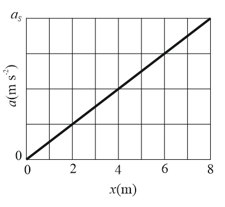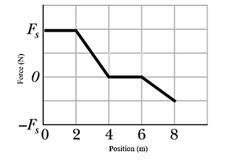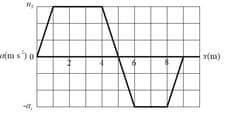A spring and block are in the arrangement as in the figure shown below. When the block is pulled out to , we must apply a force of magnitude to hold it there. We pull the block to and then release it. How much work does the spring do on the block as the block moves from to (a) , (b) , (c) , and (d) ?

Important Questions on Kinetic Energy and Work
As a body moves in the positive direction along an -axis, a single force acts on it. The force is given by , with in meters. The velocity at is .
(a) Find the velocity of the body at .
(b) Find the positive value of at which the body has a velocity of .
The block in the figure shown below lies on a horizontal frictionless surface and the spring constant is . Initially, the spring is at its relaxed length and the block is stationary at position Then an applied force with a constant magnitude of pulls the block in the positive direction of the -axis, stretching the spring until the block stops. When that stopping point is reached, what are
(a) the position of the block, (b) the work that has been done on the block by the applied force and (c) the work that has been done on the block by the spring force? During the block's displacement, what are (d) the block's position when its kinetic energy is maximum and (e) the value of that maximum kinetic energy?

A brick moves along an -axis. Its acceleration as a function of its position is shown in the figure shown below. The scale of the figure's vertical axis is set by . What is the net work performed on the brick by the force causing the acceleration as the brick moves from to ?

A block moves in a straight line on a horizontal frictionless surface under the influence of a force that varies with position as shown in the figure below. The scale of the figure's vertical axis is set by . How much work is done by the force as the block moves from the origin to ?

In the figure shown below gives the acceleration of a particle as an applied force moves it from rest along an axis from to . The scale of the figure's vertical axis is set by How much work has the force done on the particle when the particle reaches
(a) (b) and
(c) ?
What is the particle's speed and direction of travel when it reaches
(d)
(e) and (f) ?

A block is initially at rest on a horizontal frictionless surface when a horizontal force along an -axis is applied to the block. The force is given by where, is in meters and the initial position of the block is .
(a) What is the kinetic energy of the block as it passes through ?
(b) What is the maximum kinetic energy of the block between and ?
